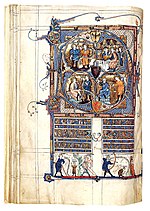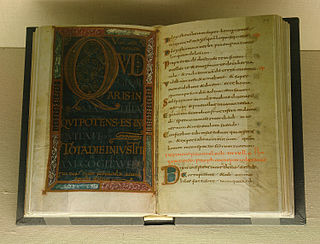
A psalter is a volume containing the Book of Psalms, often with other devotional material bound in as well, such as a liturgical calendar and litany of the Saints. Until the emergence of the book of hours in the Late Middle Ages, psalters were the books most widely owned by wealthy lay persons. They were commonly used for learning to read. Many Psalters were richly illuminated, and they include some of the most spectacular surviving examples of medieval book art.

The Melisende Psalter is an illuminated manuscript commissioned around 1135 in the crusader Kingdom of Jerusalem, probably by King Fulk for his wife Queen Melisende. It is a notable example of Crusader art, which resulted from a merging of the artistic styles of Roman Catholic Europe, the Eastern Orthodox Byzantine Empire and the art of the Armenian illuminated manuscript.

The Vespasian Psalter is an Anglo-Saxon illuminated psalter decorated in a partly Insular style produced in the second or third quarter of the 8th century. It contains an interlinear gloss in Old English which is the oldest extant English translation of any portion of the Bible. It was produced in southern England, perhaps in St. Augustine's Abbey or Christ Church, Canterbury or Minster-in-Thanet, and is the earliest illuminated manuscript produced in "Southumbria" to survive.

The Tree of Jesse is a depiction in art of the ancestors of Jesus Christ, shown in a branching tree which rises from Jesse of Bethlehem, the father of King David. It is the original use of the family tree as a schematic representation of a genealogy.

The Luttrell Psalter is an illuminated psalter commissioned by Sir Geoffrey Luttrell (1276–1345), lord of the manor of Irnham in Lincolnshire, written and illustrated on parchment circa 1320–1340 in England by anonymous scribes and artists.

The Paris Psalter is a Byzantine illuminated manuscript, 38 x 26.5 cm in size, containing 449 folios and 14 full-page miniatures. The Paris Psalter is considered a key monument of the so-called Macedonian Renaissance, a 10th-century renewal of interest in classical art closely identified with the emperor Constantine VII Porphyrogenitus (909-959) and his immediate successors.
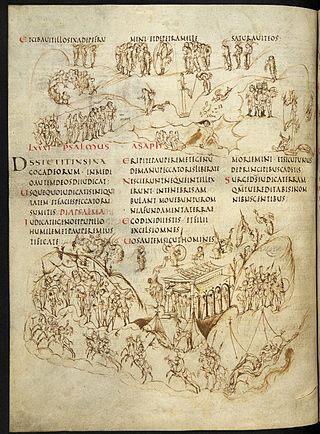
The Utrecht Psalter is a ninth-century illuminated psalter which is a key masterpiece of Carolingian art; it is probably the most valuable manuscript in the Netherlands. It is famous for its 166 lively pen illustrations, with one accompanying each psalm and the other texts in the manuscript. The precise purpose of these illustrations, and the extent of their dependence on earlier models, have been matters of art-historical controversy. The psalter spent the period between about 1000 to 1640 in England, where it had a profound influence on Anglo-Saxon art, giving rise to what is known as the "Utrecht style". It was copied at least three times in the Middle Ages. A complete facsimile edition of the psalter was made in 1875, and another in 1984 (Graz).

There exist a number of translations of the Book of Psalms into the Latin language. They are a resource used in the Liturgy of the Hours and other forms of the canonical hours in the Latin liturgical rites of the Catholic Church.

The Stowe Psalter is a psalter from the "2nd or 3rd quarter of the 11th century", at the end of Anglo-Saxon art. The text includes the Gallican version of the Psalms, followed by the Canticles with an interlinear Old English gloss.

The Hunterian Psalter is an illuminated manuscript of the 12th century. It was produced in England some time around 1170, and is considered a striking example of Romanesque book art. The work is part of the collection of the Glasgow University Library, cataloged as Sp Coll MS Hunter U.3.2 (229), which acquired the book in 1807. It derives its colloquial name, the "Hunterian Psalter", from having been part of the collection of 18th century Scottish anatomist and book collector William Hunter, who willed his collection to the University. It has also at times been known as the "York Psalter", owing to its supposed northern English origin in the city of York.
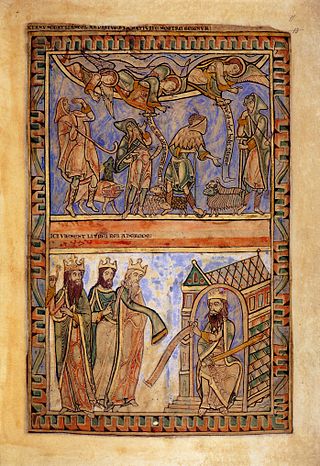
The Winchester Psalter is an English 12th-century illuminated manuscript psalter, also sometimes known as the Psalter of Henry of Blois, and formerly known as the St Swithun's Psalter. It was probably made for use in Winchester, most scholars agreeing that the most likely patron was the Henry of Blois, brother of Stephen, King of England, and Bishop of Winchester from 1129 until his death in 1171. Until recent decades it was "a little-studied masterpiece of English Romanesque painting", but it has been the subject of several recent studies.

The Eadwine Psalter or Eadwin Psalter is a heavily illuminated 12th-century psalter named after the scribe Eadwine, a monk of Christ Church, Canterbury, who was perhaps the "project manager" for the large and exceptional book. The manuscript belongs to Trinity College, Cambridge and is kept in the Wren Library. It contains the Book of Psalms in three languages: three versions in Latin, with Old English and Anglo-Norman translations, and has been called the most ambitious manuscript produced in England in the twelfth century. As far as the images are concerned, most of the book is an adapted copy, using a more contemporary style, of the Carolingian Utrecht Psalter, which was at Canterbury for a period in the Middle Ages. There is also a very famous full-page miniature showing Eadwine at work, which is highly unusual and possibly a self-portrait.
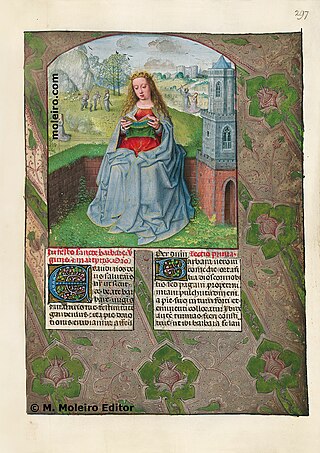
The Isabella Breviary is a late 15th-century illuminated manuscript housed in the British Library, London. Queen Isabella I of Castile was given the manuscript shortly before 1497 by her ambassador Francisco de Rojas to commemorate the double marriage of her children and the children of Emperor Maximilian of Austria and Duchess Mary of Burgundy.

The Howard Psalter and Hours is a 14th-century illuminated prayerbook. It includes a liturgical Psalter with canticles and litany, the Office of the Dead, a calendar of East Anglian origin and an incomplete Hours of the Passion. It was produced between 1310 and 1320. It is written in Latin in a Gothic script in two columns per page. There are 115 extant folios which measure 360 by 235 mm. The text block occupies an area of 250 by 166 mm. It is bound together with the De Lisle Psalter, a contemporary psalter.

The Isabella Psalter, also called the Psalter of Queen Isabella or the Psalter of Isabella of England, is a 14th-century volume containing the Book of Psalms, named for Isabella of France, who is herself depicted in it; it was likely a gift upon her betrothal or marriage. The illuminated manuscript is also notable for its bestiary.

The Gorleston Psalter is a 14th-century manuscript notable for containing early music instruction and for its humorous marginalia. It is named for the town of Gorleston in Norfolk.

The Munich Serbian Psalter is a 14th-century illuminated psalter written in Church Slavonic of the Serbian recension. With its 229 leaves illustrated with 148 miniatures, it is regarded as the most extensively illuminated Serbian manuscript book. It was written after 1370 in Moravian Serbia, either for its ruler Prince Lazar, or more likely, for his successor Stefan Lazarević. The book was rebound in 1630 by Serbian Patriarch Pajsije. It was taken to Bavaria in the late 17th century, and has been kept in the Bavarian State Library in Munich since the beginning of the 19th century.

The Sankt Florian Psalter or Saint Florian Psalter is a brightly illuminated trilingual manuscript psalter, written between late 14th and early 15th centuries in Latin, Polish and German. The Polish text is the oldest known translation of the Book of Psalms into that language. Its author, first owners, and place of origin are still not certain. It was named after St. Florian Monastery in Sankt Florian, a town in Austria, where it was discovered.
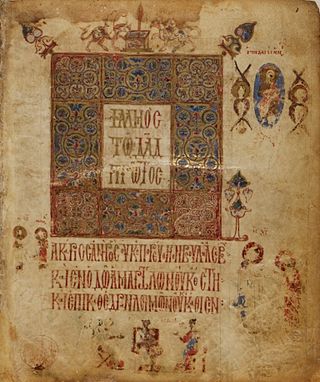
The Theodore Psalter is an illustrated manuscript and compilation of the Psalms and the canticles, or Odes from the Old Testament. "This Psalter has been held in the British Library since 1853 as Additional 19.352," wrote Princeton Art History professor Charles Barber in his first essay that is a companion to the Theodore Psalter E-Facsimile. Barber called the Psalter, "One of the richest illuminated manuscripts to survive from Byzantium."
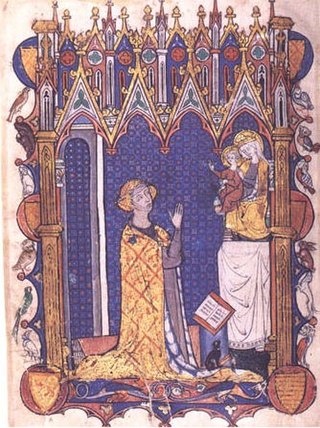
The Psalter–Hours of Yolande de Soissons is an illuminated manuscript produced in Amiens between about 1290 and 1297. It is currently kept at the Morgan Library in New York, accession number MS M.729.
